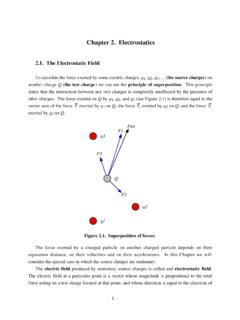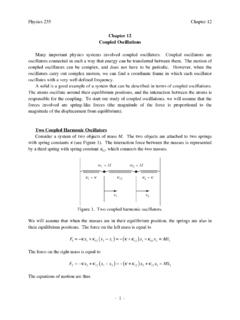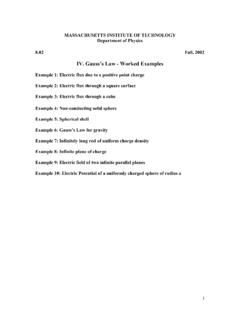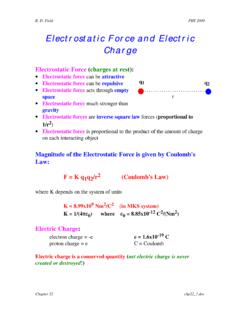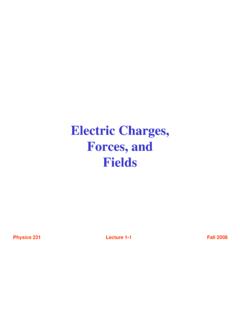Transcription of 5.1. The Magnetic Field - University of Rochester
1 - 1 -Chapter 5. The Magnetic FieldConsider two parallel straight wires in which current is flowing. The wires are neutral andtherefore there is no net electric force between the wires. Nevertheless, if the current in bothwires is flowing in the same direction, the wires are found to attract each other. If the current inone of the wires is reversed, the wires are found to repel each other. The force responsible forthe attraction and repulsion is called the Magnetic force. The Magnetic force acting on a movingcharge q is defined in terms of the Magnetic Field :F Magnetic =qv B ()The vector product is required since observations show that the force acting on a moving chargeis perpendicular to the direction of the moving charge.
2 In a region where there is an electric fieldand a Magnetic Field the total force on the moving force is equal toF total=F electric +F Magnetic =qE +qv B ()This equation is called the Lorentz force law and provides us with the total electromagneticforce acting on q. An important difference between the electric Field and the Magnetic Field isthat the electric Field does work on a charged particle (it produces acceleration or deceleration)while the Magnetic Field does not do any work on the moving charge. This is a directconsequence of the Lorentz force law:dWmagnetic=F Magnetic dl =qv B () v []dt=0We conclude that the Magnetic force can alter the direction in which a particle moves, but cannot change its : Problem particle of charge q enters the region of uniform Magnetic Field B (pointing into the page).
3 The Field deflects the particle a distance d above the original line of flight, as shown in Is the charge positive or negative? In terms of a, d, B, and q, find the momentum of order to produce the observed deflection, the force on q at the entrance of the Field regionmust be directed upwards (see Figure ). Since direction of motion of the particle and thedirection of the Magnetic Field are known, the Lorentz force law can be used to determine the- 2 -direction of the Magnetic force acting on a positive charge and on a negative charge. The vectorproduct between v and B points upwards in Figure (use the right-hand rule).
4 This showsthat the charge of the particle is x B v a d q Field RegionFigure 1. Problem magnitude of the force acting on the moving charge is equal toFmagnetic=qvBAs a result of the Magnetic force, the charged particle will follow a spherical trajectory. Theradius of the trajectory is determined by the requirement that the Magnetic force provides thecentripetal force:Fcent=mv2r=Fmagnetic=qvBIn this equation r is the radius of the circle that describes the circular part of the trajectory ofcharge q. The equation can be used to calculate r:r=mvqB=pqBwhere p is the momentum of the particle.
5 Figure shows the following relation between r, dand a:r-d()2+a2=r2 This equation can be used to express r in terms of d and a:- 3 -r=d2+a22dThe momentum of the charge q is therefore equal top=qBr=d2+a22dqBv a d q qr r Figure 2. Problem electric current in a wire is due to the motion of the electrons in the wire. The directionof current is defined to be the direction in which the positive charges move. Therefore, in aconductor the current is directed opposite to the direction of the electrons. The magnitude of thecurrent is defined as the total charge per unit time passing a given point of the wire (I = dq/dt).
6 Ifthe current flows in a region with a non-zero Magnetic Field then each electron will experience amagnetic force. Consider a tiny segment of the wire of length dl. Assume that the electrondensity is -l C/m and that each electron is moving with a velocity v. The Magnetic force exertedby the Magnetic Field on a single electron is equal todF 1e=-ev B ()A segment of the wire of length dl contains l dl/e electrons. Therefore the Magnetic force actingin this segment is equal todF Magnetic =ldledF 1e=-ldlv B ()=lvdl B ()=Idl B ()Here we have used the definition of the current I in terms of dq and dt:- 4 -I=dqdt=dqdldldt=lvIn this derivation we have defined the direction of dl to be equal to the direction of the current(and therefore opposite to the direction of the velocity of the electrons).
7 The total force on thewire is therefore equal toF Magnetic =dF magneticwire =Idl B ()wire Here I have assumed that the current is constant throughout the wire. If the current is flowingover a surface, it is usually described by a surface current density K , which is the current perunit length-perpendicular-to-flow. The force on a surface current is equal toF Magnetic =K B ()dasurface If the current flows through a volume, is it is usually described in terms of a volume currentdensity J . The Magnetic force on a volume current is equal toF Magnetic =J B ()dtvolume The surface integral of the current density J across the surface of a volume V is equal to thetotal charge leaving the volume per unit time (charge conservation).
8 J da Surface =-ddtrdtVolume Using the divergence theorem we can rewrite this expression asJ da Surface = J []dtVolume =-ddtrdtVolume Since this must hold for any volume V we must require that J =-drdtThis equation is known as the continuity 5 The Biot-Savart LawIn this Section we will discuss the Magnetic Field produced by a steady current. A steadycurrent is a flow of charge that has been going on forever, and will be going on forever. Thesecurrents produce Magnetic fields that are constant in time. The Magnetic Field produced by asteady line current is given by the Biot-Savart Law:B P()=m04pI D r Dr2dlLine =m0I4pdl D r Dr2 Line where dl is an element of the wire, r is the vector connecting the element of the wire and P, andm0 is the permeability constant which is equal tom0=4p 10-7 N/A2 The unit of the Magnetic Field is the Tesla (T).
9 For surface and volume currents the Biot-Savartlaw can be rewritten asB P()=m04pK D r Dr2daSurface andB P()=m04pJ D r Dr2dtVolume Example: Problem the Magnetic Field at point P for each of the steady current configurations shown inFigure )The total Magnetic Field at P is the vector sum of the Magnetic fields produced by the foursegments of the current loop. Along the two straight sections of the loop, r and dl are parallelor opposite, and thus dl r =0. Therefore, the Magnetic Field produced by these two straightsegments is equal to zero. Along the two circular segments r and dl are perpendicular.
10 Usingthe right-hand rule it is easy to show thatB bP()=m0I4pdl b b2 Line =-m0I4p12pbb2 k =-m0I8b k and- 6 -B aP()=m0I4pdl a a2 Line =m0I4p12paa2 k =m0I8a k where z is pointing out of the paper. The total Magnetic Field at P is therefore equal toB totalP()=m0I81a-1b k abIIRIIb)a)PPFigure Problem ) The Magnetic Field at P produced by the circular segment of the current loop is equal toB RP()=m0I4pdl R R2 Line =-m0I4ppRR2 k =-m0I4R k where z is pointing out of the paper. The Magnetic Field produced at P by each of the two linearsegments will also be directed along the negative z axis.
